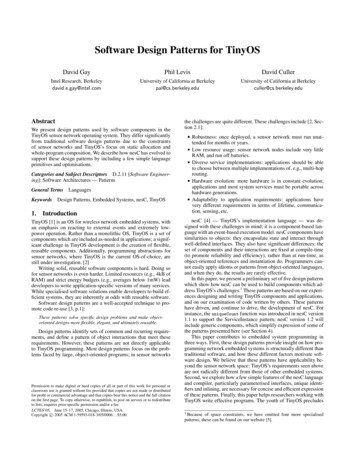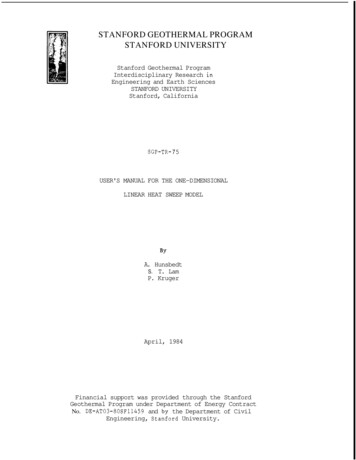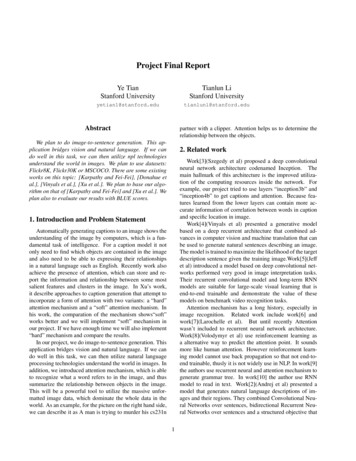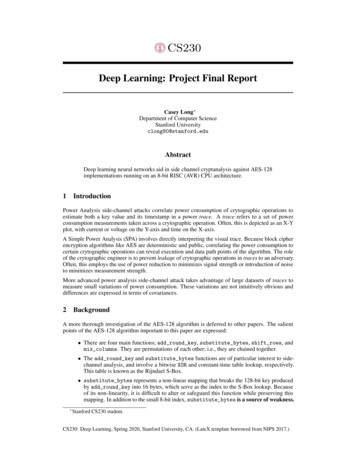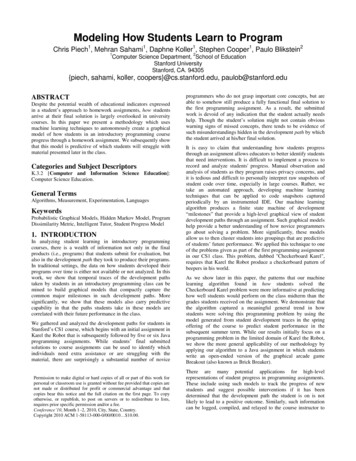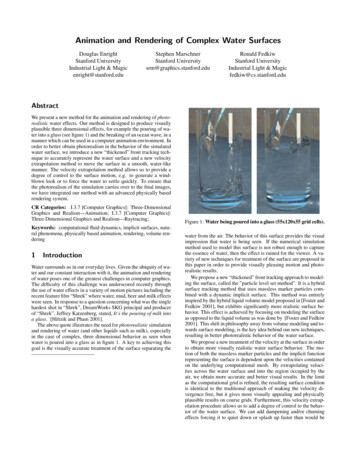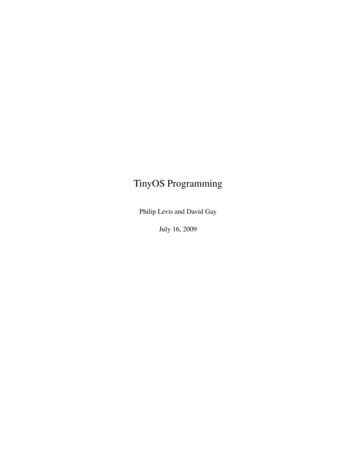
Transcription
TinyOS ProgrammingPhilip Levis and David GayJuly 16, 2009
iiAcknolwedgementsWe’d like to thank several people for their contributions to this book. First is Mike Horton, of Crossbow,Inc., who first proposed writing it. Second is Pablo Guerrero, who gave detailed comments and corrections.Third is Joe Polastre of Moteiv, who gave valable feedback on how to better introduce generic components.Fourth, we’d like to thank Phil’s father, who although he doesn’t program, read the entire thing! Fifth, JohnRegehr, Ben Greenstein and David Culler provided valuable feedback on this expanded edition. Last butnot least, we would like to thank the TinyOS community and its developers. Many of the concepts in thisbook – power locks, tree routing, and interface type checking – are the work and ideas of others, which wemerely present.Chapter 10 of this book is based on: Software design patterns for TinyOS, in ACM Transactions onEmbedded Computing Systems (TECS), Volume 6, Issue 4 (September 2007), c ACM, 2007.http://doi.acm.org/10.1145/1274858.1274860
ContentsITinyOS and nesC11Introduction1.1 Networked, Embedded Sensors . . . . . .1.1.1 Anatomy of a Sensor Node (Mote)1.2 TinyOS . . . . . . . . . . . . . . . . . .1.2.1 What TinyOS provides . . . . . .1.3 Example Application . . . . . . . . . . .1.4 Compiling and Installing Applications . .1.5 The rest of this book . . . . . . . . . . .334556772II3.Names and Program Structure2.1 Hello World! . . . . . . . . . . . . . . . . . . . . . . . .2.2 Essential Differences: Components, Interfaces and Wiring2.3 Wiring and Callbacks . . . . . . . . . . . . . . . . . . . .2.4 Summary . . . . . . . . . . . . . . . . . . . . . . . . . .9. 9. 12. 13. 14Basic Programming17Components and interfaces3.1 Component signatures . . . . . . . . . . . . . . . . . . . . . .3.1.1 Visualizing components . . . . . . . . . . . . . . . . .3.1.2 The “as” keyword and clustering interfaces . . . . . . .3.1.3 Clustering interfaces . . . . . . . . . . . . . . . . . . .3.2 Interfaces . . . . . . . . . . . . . . . . . . . . . . . . . . . . .3.2.1 Generic Interfaces . . . . . . . . . . . . . . . . . . . .3.2.2 Bidirectional Interfaces . . . . . . . . . . . . . . . . . .3.3 Component implementations . . . . . . . . . . . . . . . . . . .3.3.1 Modules . . . . . . . . . . . . . . . . . . . . . . . . .3.3.2 A basic configuration . . . . . . . . . . . . . . . . . . .3.3.3 Module variables . . . . . . . . . . . . . . . . . . . . .3.3.4 Generic Components . . . . . . . . . . . . . . . . . . .3.4 Split-phase interfaces . . . . . . . . . . . . . . . . . . . . . . .3.4.1 Read . . . . . . . . . . . . . . . . . . . . . . . . . . .3.4.2 Send . . . . . . . . . . . . . . . . . . . . . . . . . . .3.5 Module memory allocation, avoiding recursion, and other details3.5.1 Memory ownership and split-phase calls . . . . . . . . .iii.191920202122242526262728293031323233
Contents.363739404142Configurations and wiring4.1 Configurations . . . . . . . . . . . . . .4.1.1 The - and - operators . . . .4.1.2 The operator . . . . . . . . .4.1.3 Namespace Management . . . .4.1.4 Wiring Rules . . . . . . . . . .4.1.5 Wiring Shortcuts . . . . . . . .4.2 Building abstractions . . . . . . . . . .4.2.1 Component naming . . . . . . .4.2.2 Component Initialization . . . .4.3 Component Layering . . . . . . . . . .4.3.1 Extensibility . . . . . . . . . .4.3.2 Hardware specificity . . . . . .4.4 Multiple Wirings . . . . . . . . . . . .4.4.1 Fan-in and Fan-out . . . . . . .4.4.2 Uses of Multiple Wiring . . . .4.4.3 Combine Functions . . . . . . .4.5 Generics versus Singletons . . . . . . .4.5.1 Generic components, revisited .4.5.2 Singleton components, revisited4.6 Exercises . . . . . . . . . . . . . . . on model5.1 Overview . . . . . . . . . . . . .5.2 Tasks . . . . . . . . . . . . . . .5.2.1 Task timing . . . . . . . .5.2.2 Timing and event handlers5.3 Tasks and split-phase calls . . . .5.3.1 Hardware versus software5.3.2 Tasks and call loops . . .5.4 Exercises . . . . . . . . . . . . 2 Constants and saving memory3.5.3 Platform Independent Types .3.5.4 Global names . . . . . . . . .3.5.5 nesC and the C preprocessor .3.5.6 C Libraries . . . . . . . . . .Exercises . . . . . . . . . . . . . . .Applications6.1 The basics: timing, LEDs and booting6.1.1 Deadline-based timing . . . .6.1.2 Wiring AntiTheftC . . . . . .6.2 Sensing . . . . . . . . . . . . . . . .6.2.1 Simple sampling . . . . . . .6.2.2 Sensor components . . . . . .6.2.3 Sensor values, calibration . .6.2.4 Stream sampling . . . . . . .
vContents6.36.46.56.67IIISingle-hop networking . . . . . . . . . . . . . . . . . . . . . . .6.3.1 Sending packets . . . . . . . . . . . . . . . . . . . . . .6.3.2 Receiving packets . . . . . . . . . . . . . . . . . . . . .6.3.3 Selecting a communication stack . . . . . . . . . . . . . .Multi-hop networking: collection, dissemination and base stations6.4.1 Collection . . . . . . . . . . . . . . . . . . . . . . . . . .6.4.2 Dissemination . . . . . . . . . . . . . . . . . . . . . . .6.4.3 Wiring collection and dissemination . . . . . . . . . . . .6.4.4 Base station for collection and dissemination . . . . . . .Storage . . . . . . . . . . . . . . . . . . . . . . . . . . . . . . .6.5.1 Volumes . . . . . . . . . . . . . . . . . . . . . . . . . . .6.5.2 Configuration data . . . . . . . . . . . . . . . . . . . . .6.5.3 Block and Log storage . . . . . . . . . . . . . . . . . . .Exercises . . . . . . . . . . . . . . . . . . . . . . . . . . . . . .Mote-PC communication7.1 Basics . . . . . . . . . . . . . . . . . . . . . . . . .7.1.1 Serial Communication Stack . . . . . . . . .7.2 Using mig . . . . . . . . . . . . . . . . . . . . . . .7.2.1 Sending and receiving mig-generated packets7.3 Using ncg . . . . . . . . . . . . . . . . . . . . . . .7.4 Packet Sources . . . . . . . . . . . . . . . . . . . .7.5 Example: Simple Reliable Transmission . . . . . . .7.5.1 Reliable Transmission Protocol . . . . . . .7.5.2 Reliable Transmission in Java . . . . . . . .7.5.3 Reimplementing TestSerial . . . . . . . . . .7.6 Exercises . . . . . . . . . . . . . . . . . . . . . . .Advanced 1021041051061061071101101118Advanced Components1139Advanced Wiring11510 Design Patterns11711 Advanced Concurrency11912 Device drivers and the hardware abstraction architecture (HAA)12113 Advanced Applications123IV125Appendix and ReferencesA TinyOS APIs127A.1 Booting . . . . . . . . . . . . . . . . . . . . . . . . . . . . . . . . . . . . . . . . . . . . . 127A.2 Communication . . . . . . . . . . . . . . . . . . . . . . . . . . . . . . . . . . . . . . . . . 127
ContentsA.3A.4A.5A.6A.7A.8A.2.1 Single-hop . . . . . . . .A.2.2 Multihop collection . . . .A.2.3 Multihop dissemination .A.2.4 Binary Reprogramming .Time . . . . . . . . . . . . . . . .Sensing . . . . . . . . . . . . . .Storage . . . . . . . . . . . . . .Data structures . . . . . . . . . .A.6.1 BitVectorC . . . . . . . .A.6.2 QueueC . . . . . . . . . .A.6.3 BigQueueC . . . . . . . .A.6.4 PoolC . . . . . . . . . . .A.6.5 StateC . . . . . . . . . . .Utilities . . . . . . . . . . . . . .A.7.1 Random numbers . . . . .A.7.2 Leds . . . . . . . . . . . .A.7.3 Cyclic redundancy checksA.7.4 Printf . . . . . . . . . . .Low Power . . . . . . . . . . . 34134134135
Code p in C . . . . . . . . . . . . . . . . . . . . . . . . . . . . .PowerupC module in nesC . . . . . . . . . . . . . . . . . . . . . .Simple nesC interfaces . . . . . . . . . . . . . . . . . . . . . . . .PowerupAppC configuration in nesC . . . . . . . . . . . . . . . . .Powerup with blinking LED in C . . . . . . . . . . . . . . . . . . .Powerup with blinking LED in nesC (slightly simplified) . . . . . .Powerup with blinking LED configuration (slightly simplified) . . .The signature and implementation blocks . . . . . . . . . . . . . .Signatures of PowerupC and LedsC . . . . . . . . . . . . . . . . .MainC’s signature . . . . . . . . . . . . . . . . . . . . . . . . . . .The LedsP module . . . . . . . . . . . . . . . . . . . . . . . . . .PowerupC and an alternative signature . . . . . . . . . . . . . . . .Interface declarations for Leds and Boot . . . . . . . . . . . . . . .The Init and Boot interfaces. . . . . . . . . . . . . . . . . . . . . .Signatures of MainC and PowerupC . . . . . . . . . . . . . . . . .The Queue interface . . . . . . . . . . . . . . . . . . . . . . . . . .Using a queue of 32–bit integers . . . . . . . . . . . . . . . . . . .Providing a 16–bit or a 32–bt queue . . . . . . . . . . . . . . . . .The Notify interface . . . . . . . . . . . . . . . . . . . . . . . . . .UserButtonC . . . . . . . . . . . . . . . . . . . . . . . . . . . . .Simplified Timer interface showing three commands and one event .PowerupC module code . . . . . . . . . . . . . . . . . . . . . . . .The module PowerupToggleC . . . . . . . . . . . . . . . . . . . .The PowerupToggleAppC configuration . . . . . . . . . . . . . . .Example uses of the components keyword . . . . . . . . . . . . . .The Get interface . . . . . . . . . . . . . . . . . . . . . . . . . . .A Self–Incrementing Counter . . . . . . . . . . . . . . . . . . . . .Generic module SineSensorC and generic configuration TimerMilliCInstantiating a generic component . . . . . . . . . . . . . . . . . .Signature of BitVectorC . . . . . . . . . . . . . . . . . . . . . . . .QueueC signature . . . . . . . . . . . . . . . . . . . . . . . . . . .The Read interface . . . . . . . . . . . . . . . . . . . . . . . . . .The split–phase Send interface . . . . . . . . . . . . . . . . . . . .The Send interface . . . . . . . . . . . . . . . . . . . . . . . . . .The Receive interface . . . . . . . . . . . . . . . . . . . . . . . . .The signature of PoolC . . . . . . . . . . . . . . . . . . . . . . . .CC2420 packet header . . . . . . . . . . . . . . . . . . . . . . . .The dreaded “packed” attribute in the 1.x MintRoute library . . . 72828292930303031323434363737
Code 6.26.36.46.56.66.86.96.106.11The CC2420 header . . . . . . . . . . . . . . . . . . . . . . .TinyError.h, a typical nesC header file . . . . . . . . . . . . .Including a header file in a component . . . . . . . . . . . . .Indirectly including a header file . . . . . . . . . . . . . . . .Fancy.nc: C preprocessor example . . . . . . . . . . . . . . .FancyModule.nc: C preprocessor pitfalls . . . . . . . . . . . .Fancy.h: the reliable way to use C preprocessor symbols . . .Using a C library function . . . . . . . . . . . . . . . . . . .Signature of part of the CC1000 radio stack . . . . . . . . . .The PowerupToggleAppC configuration revisited . . . . . . .C code generated from the PowerupToggleAppC configurationThe LedsC configuration . . . . . . . . . . . . . . . . . . . .CC2420ReceiveC’s use of the as keyword . . . . . . . . . . .Naming generic component instances . . . . . . . . . . . . .MainC and LedsP . . . . . . . . . . . . . . . . . . . . . . . .Valid alternate of PowerupToggleAppC . . . . . . . . . . . .Invalid alternate of PowerupToggleAppC . . . . . . . . . . .LedsC revisited . . . . . . . . . . . . . . . . . . . . . . . . .BlinkC signature . . . . . . . . . . . . . . . . . . . . . . . .The RandomC configuration . . . . . . . . . . . . . . . . . .The RandomMlcgC signature . . . . . . . . . . . . . . . . . .Seed Initialization in RandomMlcgP . . . . . . . . . . . . . .ActiveMessageC for the CC2420 . . . . . . . . . . . . . . . .The signature of CC2420ActiveMessageC . . . . . . . . . . .Fan–out on CC2420TransmitC’s Init . . . . . . . . . . . . . .StdControl and SplitControl initialization interfaces . . . . . .Why the metaphor of “wires” is only a metaphor . . . . . . .The combine function for error t . . . . . . . . . . . . . . . .Fan–out on SoftwareInit . . . . . . . . . . . . . . . . . . . .Resulting code from fan–out on SoftwareInit . . . . . . . . .AMSenderC signature . . . . . . . . . . . . . . . . . . . . .RadioCountToLedsAppC . . . . . . . . . . . . . . . . . . . .PoolC . . . . . . . . . . . . . . . . . . . . . . . . . . . . . .Exposing a generic component instance as a singleton . . . . .The main TinyOS scheduling loop from SchedulerBasicP.nc .A troublesome implementation of a magnetometer sensor . . .Signal handler that can lead to an infinite loop . . . . . . . . .An improved implementation of FilterMagC . . . . . . . . . .Anti–theft: simple flashing LED . . . . . . . . . . . . . . . .The Leds interface . . . . . . . . . . . . . . . . . . . . . . .The Boot interface . . . . . . . . . . . . . . . . . . . . . . .The full Timer interface . . . . . . . . . . . . . . . . . . . . .WarningTimer.fired with drift problem fixed . . . . . . . . . .Anti–Theft: application–level configuration . . . . . . . . . .Anti–theft: detecting dark conditions . . . . . . . . . . . . . .Anti–Theft: wiring to light sensor . . . . . . . . . . . . . . .ReadStream Interface . . . . . . . . . . . . . . . . . . . . . .Anti–theft: detecting movement . . . . . . . . . . . . . . . 78
ixCode 17.12The AMSend interface . . . . . . . . . . . . . . . . . . . . . . . . . . . . .Anti–Theft: reporting theft over the radio . . . . . . . . . . . . . . . . . . .The SplitControl interface . . . . . . . . . . . . . . . . . . . . . . . . . . .Anti–Theft: changing settings . . . . . . . . . . . . . . . . . . . . . . . . .Serial vs Radio–based AM components . . . . . . . . . . . . . . . . . . . .Anti–Theft: reporting theft over a collection tree . . . . . . . . . . . . . . . .DisseminationValue interface . . . . . . . . . . . . . . . . . . . . . . . . . .Anti–Theft: settings via a dissemination tree . . . . . . . . . . . . . . . . . .The StdControl interface . . . . . . . . . . . . . . . . . . . . . . . . . . . .The DisseminationUpdate interface . . . . . . . . . . . . . . . . . . . . . .AntiTheft base station code: disseminating settings . . . . . . . . . . . . . .The RootControl interface . . . . . . . . . . . . . . . . . . . . . . . . . . .AntiTheft base station code: reporting thefts . . . . . . . . . . . . . . . . . .AntiTheft base station wiring . . . . . . . . . . . . . . . . . . . . . . . . . .ConfigStorageC signature . . . . . . . . . . . . . . . . . . . . . . . . . . . .Mount interface for storage volumes . . . . . . . . . . . . . . . . . . . . . .ConfigStorage interface . . . . . . . . . . . . . . . . . . . . . . . . . . . . .Anti–Theft: reading settings at boot time . . . . . . . . . . . . . . . . . . . .Anti–Theft: saving configuration data . . . . . . . . . . . . . . . . . . . . .BlockStorageC signature . . . . . . . . . . . . . . . . . . . . . . . . . . . .The BlockWrite interface . . . . . . . . . . . . . . . . . . . . . . . . . . . .Simultaneously sampling and storing to flash (most error–checking ommitted)The BlockRead interface . . . . . . . . . . . . . . . . . . . . . . . . . . . .LogStorageC signature . . . . . . . . . . . . . . . . . . . . . . . . . . . . .The LogWrite interface . . . . . . . . . . . . . . . . . . . . . . . . . . . . .Logging a sample summary (error–checking ommitted) . . . . . . . . . . . .The LogRead interface . . . . . . . . . . . . . . . . . . . . . . . . . . . . .Serial AM Packet layout . . . . . . . . . . . . . . . . . . . . . . . . . . . .TestSerial packet layout . . . . . . . . . . . . . . . . . . . . . . . . . . . . .Backing array methods . . . . . . . . . . . . . . . . . . . . . . . . . . . . .Sending packets with mig and MoteIF . . . . . . . . . . . . . . . . . . . . .Interface for handling received packets . . . . . . . . . . . . . . . . . . . . .Receiving packets with mig and MoteIF . . . . . . . . . . . . . . . . . . . .Constants and packet layout for Oscillscope application . . . . . . . . . . . .Class generated by ncg . . . . . . . . . . . . . . . . . . . . . . . . . . . . .Simplified code to save received samples . . . . . . . . . . . . . . . . . . . .Reliable Transmission Protocol in Java –Transmission . . . . . . . . . . . . .Reliable Transmission Protocol in Java –Reception . . . . . . . . . . . . . .A reliable TestSerial.java . . . . . . . . . . . . . . . . . . . . . . . . . . . 69697100100102102103103104105105107109110
Code Examplesx
Programming hints, condensedProgramming Hint 1: Use the “as” keyword liberally. (page 21)Programming Hint 2: Never write recursive functions within a module. In combination with the TinyOScoding conventions, this guarantees that all programs have bounded stack usage. (page 33)Programming Hint 3: Never use malloc and free. Allocate all state in components. If your applicationrequirements necessitate a dynamic memory pool, encapsulate it in a component and try to limit the set ofusers. (page 33)Programming Hint 4: When possible, avoid passing pointers across interfaces; when this cannot be avoidedonly one component should be able to modify a pointer’s data at any time. (page 34)Programming Hint 5: Conserve memory by using enums rather than const variables for integer constants,and don’t declare variables with an enum type. (page 37)Programming Hint 6: Never, ever use the “packed” attribute in portable code. (page 38)Programming Hint 7: Use platform independent types when defining message structures. (page 38)Programming Hint 8: If you have to perform significant computation on a platform independent type oraccess it many (hundreds or more) times, temporarily copy it to a native type. (page 39)Programming Hint 9: Interfaces should #include the header files for the types they use. (page 40)Programming Hint 10: Always #define a preprocessor symbol in a header file. Use #include to load theheader file in all components and interfaces that use the symbol. (page 41)Programming Hint 11: If a component is a usable abstraction by itself, its name should end with C. If it isintended to be an internal and private part of a larger abstraction, its name should end with P. Never wire toP components from outside your package (directory). (page 50)Programming Hint 12: Auto-wire Init to MainC in the top-level configuration of a software abstraction.(page 52)Programming Hint 13: When using layered abstractions, components should not wire across multipleabstraction layers: they should wire to a single layer. (page 54)Programming Hint 14: Never ignore combine warnings. (page 58)Programming Hint 15: Keep tasks short. (page 66)Programming Hint 16: If an event handler needs to make possibly long-executing command calls, post atask to make the calls. (page 66)Programming Hint 17: Don’t signal events from commands — the command should post a task that signalsthe event. (page 68)xi
Programming hints, condensedxii
PrefaceThis book provides an in-depth introduction to writing nesC code for the TinyOS 2.0 operating system.While it goes into greater depth than the TinyOS tutorials on this subject, there are several topics that areoutside its scope, such as the structure and implementation of radio stacks or existing TinyOS libraries. Itfocuses on how to write nesC code, and explains the concepts and reasons behind many of the nesC andTinyOS design decisions. If you are interested in a brief introduction to TinyOS programming, then youshould probably start with the tutorials. If you’re interested in details on particular TinyOS subsystems youshould probably consult TEPs (TinyOS Enhancement Proposals), which detail the corresponding designconsiderations, interfaces, and components. Both of these can be found in the doc/html directory of aTinyOS distribution.While some of the contents of this book are useful for 1.x versions of TinyOS, they do have severaldifferences from TinyOS 2.0 which can lead to different programming practices. If in doubt, referring to theTEP on the subject is probably the best bet, as TEPs often discuss in detail the differences between 1.x and2.0.For someone who has experience with C or C , writing simple nesC programs is fairly straightforward:all you need to do is implement one or two modules and wire them together. The difficulty (and intellectualchallenge) comes when building larger applications. The code inside TinyOS modules is fairly analogous toC coding, but configurations – which stitch together components – are not.This book is a first attempt to explain how nesC relates to and differs from other C dialects, steppingthrough how the differences lead to very different coding styles and approaches. As a starting point, thisbook assumes that1. you know C, C , or Java reasonably well, understand pointers and that2. you have taken an undergraduate level operating systems class (or equivalent) and know about concurrency,interrupts and preemption.Of course, this book is as much a description of nesC as it is an argument for a particular way of usingthe language to achieve software engineering goals. In this respect, it is the product of thousands of hours ofwork by many people, as they learned and explored the use of the language. In particular, Cory Sharp, KevinKlues, and Vlado Handziski have always pushed the boundaries of nesC programming in order to betterunderstand which practices lead to the simplest, most efficient, and robust code. In particular, Chapter 10 isan edited version of a paper we wrote together, while using structs as a compile-time checking mechanismin interfaces (as Timer does) is an approach invented by Cory.This book is divided into four parts. The first part, Chapters 1–2, gives a high-level overview of TinyOSand the nesC language. The second part, Chapters 3–7 goes into nesC and TinyOS at a level sufficientfor writing applications. The third part, not included in this online version of the text, goes into moreadvanced TinyOS and nesC programming, as is sometimes needed when writing new low-level systems orhigh performance applications. The book ends with an appendix summarizing the basic application-levelTinyOS APIs.xiii
Prefacexiv
Part ITinyOS and nesC1
IntroductionThis book is about writing TinyOS systems and applications in the nesC language. This chapter gives abrief overview of TinyOS and its intended uses. TinyOS is an open-source project which a large number ofresearch universities and companies contribute to. The main TinyOS website, http://www.tinyos.net,has instructions for downloading and installing the TinyOS programming environment. The website has agreat deal of useful information which this book doesn’t cover, such as common hardware platforms andhow to install code on a node.1.1Networked, Embedded SensorsTinyOS is designed to run on small, wireless sensors. Networks of these sensors have the potential torevolutionize a wide range of disciplines, fields, and technologies. Recent example uses of these devicesinclude:Golden Gate Bridge Safety. High-speed accelerometers collect synchonized data on the movement ofand oscillations within the structure of San Francisco’s Golden Gate Bridge. This data allows the maintainersof the bridge to easily observe the structural health of the bridge in response to events such as high windsor traffic, as well as quickly assess possible damage after an earthquake [6]. Being wireless avoids the needfor installing and maintaining miles of wires.Volcanic Monitoring. Accelerometers and microphones observe seismic events on the Reventador andTungurahua volcanoes in Ecuador. Nodes locally compare when they observe events to determine theirlocation, and report aggregate data to a camp several kilometers away using a long-range wirelesss link.Small, wireless nodes allow geologists and geophysicsts to install dense, remote scientific instruments [21],obtaining data that answers otherwise questions about unapproachable environments.Datacenter Provisioning. Data centers and enterprise computing systems require huge amounts ofenergy, to the point at which they are placed in regions that have low power costs. Approximately 50% of theenergy in these systems goes into cooling, in part due to highly conservative cooling systems. By installingwireless sensors across machine racks, the data center can automatically sense what areas need cooling andcan adjust which computers do work and generate heat [12]. Dynamically adapting these factors can greatlyreduce power consumption, making the IT infrastructure more efficient and reducing environmental impact.While these three application domains are only a small slice of where networks of sensors are used, theyshow the key differences between these networks and most other computing systems. First, these “sensornetworks” need to operate unattended for long periods of time. Second, they gather data from and respond toan unpredictable environment. Finally, for reasons of cost, deployment simplicity, and robustness, they arewireless. Together, these three issues – longevity, embedment, and wireless communication – cause sensornetworks to use different approaches than traditional, wired, and human-centric or machine-centric systems.The sheer diversity of sensor network
TinyOS Programming Philip Levis and David Gay July 16, 2009. ii Acknolwedgements We'd like to thank several people for their contributions to this book. First is Mike Horton, of Crossbow, Inc., who first proposed writing it. Second is Pablo Guerrero, who gave detailed comments and corrections.
